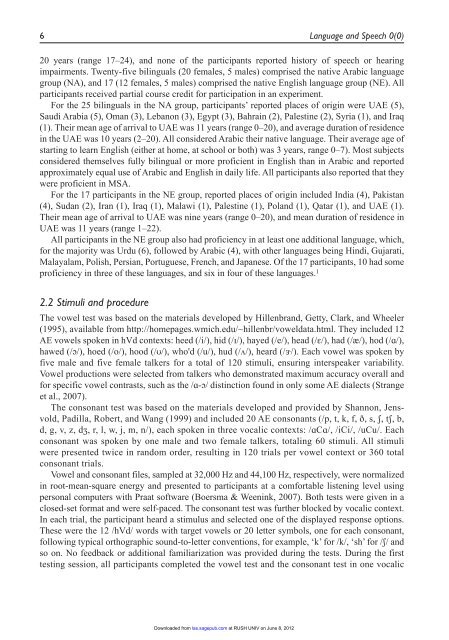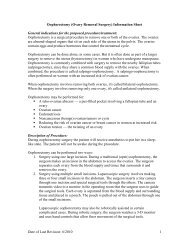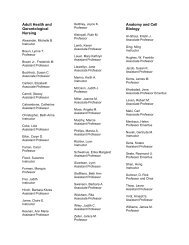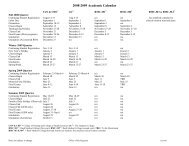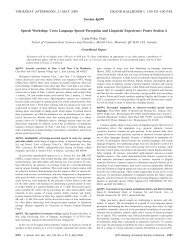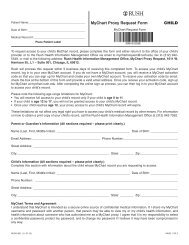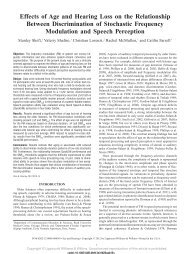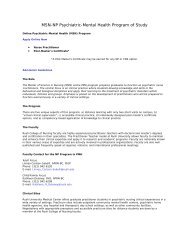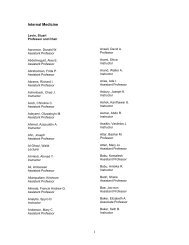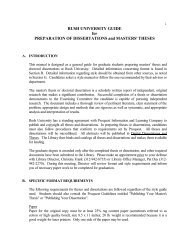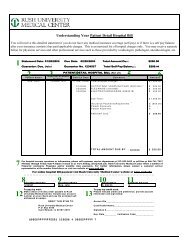English Vowels and Consonants by Native Arabic ... - Rush University
English Vowels and Consonants by Native Arabic ... - Rush University
English Vowels and Consonants by Native Arabic ... - Rush University
Create successful ePaper yourself
Turn your PDF publications into a flip-book with our unique Google optimized e-Paper software.
6 Language <strong>and</strong> Speech 0(0)20 years (range 17–24), <strong>and</strong> none of the participants reported history of speech or hearingimpairments. Twenty-five bilinguals (20 females, 5 males) comprised the native <strong>Arabic</strong> languagegroup (NA), <strong>and</strong> 17 (12 females, 5 males) comprised the native <strong>English</strong> language group (NE). Allparticipants received partial course credit for participation in an experiment.For the 25 bilinguals in the NA group, participants’ reported places of origin were UAE (5),Saudi Arabia (5), Oman (3), Lebanon (3), Egypt (3), Bahrain (2), Palestine (2), Syria (1), <strong>and</strong> Iraq(1). Their mean age of arrival to UAE was 11 years (range 0–20), <strong>and</strong> average duration of residencein the UAE was 10 years (2–20). All considered <strong>Arabic</strong> their native language. Their average age ofstarting to learn <strong>English</strong> (either at home, at school or both) was 3 years, range 0–7). Most subjectsconsidered themselves fully bilingual or more proficient in <strong>English</strong> than in <strong>Arabic</strong> <strong>and</strong> reportedapproximately equal use of <strong>Arabic</strong> <strong>and</strong> <strong>English</strong> in daily life. All participants also reported that theywere proficient in MSA.For the 17 participants in the NE group, reported places of origin included India (4), Pakistan(4), Sudan (2), Iran (1), Iraq (1), Malawi (1), Palestine (1), Pol<strong>and</strong> (1), Qatar (1), <strong>and</strong> UAE (1).Their mean age of arrival to UAE was nine years (range 0–20), <strong>and</strong> mean duration of residence inUAE was 11 years (range 1–22).All participants in the NE group also had proficiency in at least one additional language, which,for the majority was Urdu (6), followed <strong>by</strong> <strong>Arabic</strong> (4), with other languages being Hindi, Gujarati,Malayalam, Polish, Persian, Portuguese, French, <strong>and</strong> Japanese. Of the 17 participants, 10 had someproficiency in three of these languages, <strong>and</strong> six in four of these languages. 12.2 Stimuli <strong>and</strong> procedureThe vowel test was based on the materials developed <strong>by</strong> Hillenbr<strong>and</strong>, Getty, Clark, <strong>and</strong> Wheeler(1995), available from http://homepages.wmich.edu/~hillenbr/voweldata.html. They included 12AE vowels spoken in hVd contexts: heed (/i/), hid (/ɪ/), hayed (/e/), head (/ɛ/), had (/æ/), hod (/ɑ/),hawed (/ɔ/), hoed (/o/), hood (/ʊ/), who'd (/u/), hud (/ʌ/), heard (/ɝ/). Each vowel was spoken <strong>by</strong>five male <strong>and</strong> five female talkers for a total of 120 stimuli, ensuring interspeaker variability.Vowel productions were selected from talkers who demonstrated maximum accuracy overall <strong>and</strong>for specific vowel contrasts, such as the /ɑ-ɔ/ distinction found in only some AE dialects (Strangeet al., 2007).The consonant test was based on the materials developed <strong>and</strong> provided <strong>by</strong> Shannon, Jensvold,Padilla, Robert, <strong>and</strong> Wang (1999) <strong>and</strong> included 20 AE consonants (/p, t, k, f, ð, s, ʃ, tʃ, b,d, g, v, z, dʒ, r, l, w, j, m, n/), each spoken in three vocalic contexts: /ɑCɑ/, /iCi/, /uCu/. Eachconsonant was spoken <strong>by</strong> one male <strong>and</strong> two female talkers, totaling 60 stimuli. All stimuliwere presented twice in r<strong>and</strong>om order, resulting in 120 trials per vowel context or 360 totalconsonant trials.Vowel <strong>and</strong> consonant files, sampled at 32,000 Hz <strong>and</strong> 44,100 Hz, respectively, were normalizedin root-mean-square energy <strong>and</strong> presented to participants at a comfortable listening level usingpersonal computers with Praat software (Boersma & Weenink, 2007). Both tests were given in aclosed-set format <strong>and</strong> were self-paced. The consonant test was further blocked <strong>by</strong> vocalic context.In each trial, the participant heard a stimulus <strong>and</strong> selected one of the displayed response options.These were the 12 /hVd/ words with target vowels or 20 letter symbols, one for each consonant,following typical orthographic sound-to-letter conventions, for example, ‘k’ for /k/, ‘sh’ for /ʃ/ <strong>and</strong>so on. No feedback or additional familiarization was provided during the tests. During the firsttesting session, all participants completed the vowel test <strong>and</strong> the consonant test in one vocalicDownloaded from las.sagepub.com at RUSH UNIV on June 8, 2012


